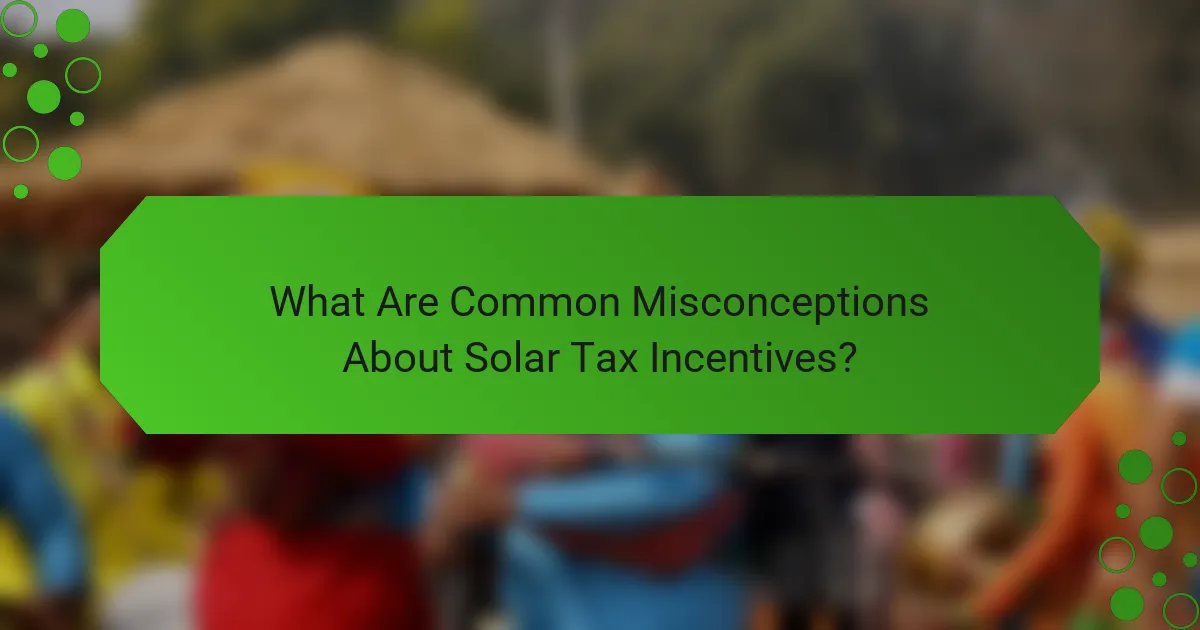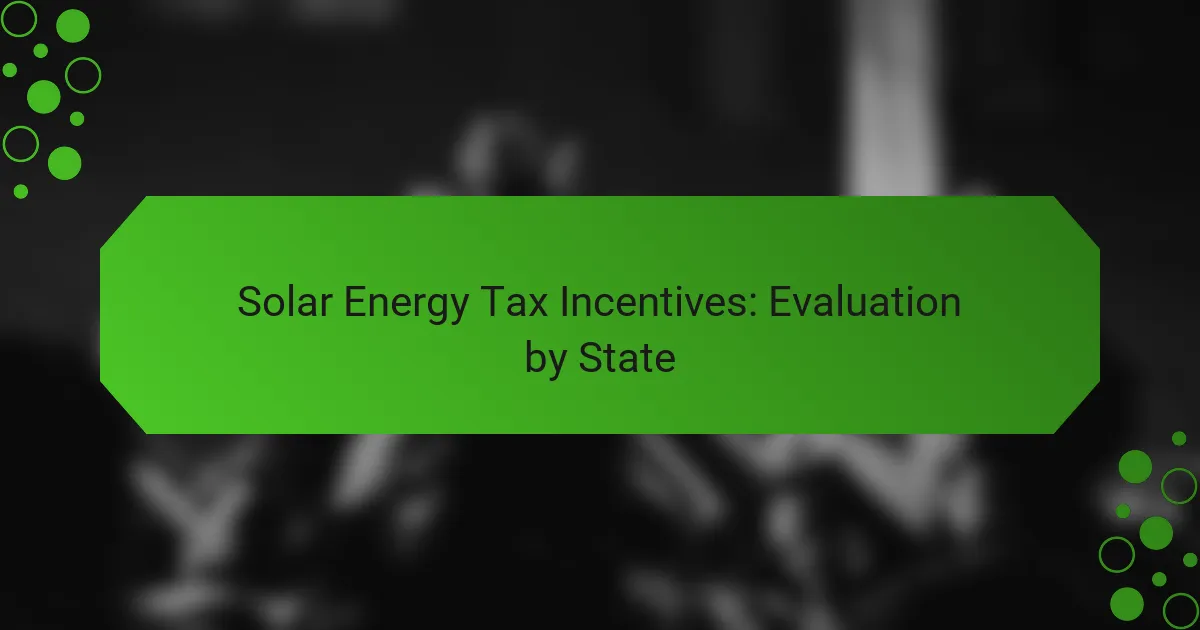Solar energy tax incentives vary significantly by state, with many offering a mix of tax credits, rebates, and performance-based incentives that lower the initial costs of solar installations. These programs not only enhance the financial feasibility of adopting solar technology for homeowners and businesses but are also influenced by federal tax credits that provide a crucial foundation for state initiatives. Understanding the eligibility criteria and specific benefits available in each state is essential for maximizing the advantages of solar energy investments.

Which States Offer the Best Solar Energy Tax Incentives?
The states that provide the best solar energy tax incentives typically offer a combination of tax credits, rebates, and performance-based incentives. These programs can significantly reduce the upfront costs of solar installations, making solar energy more accessible to homeowners and businesses.
California
California is a leader in solar energy incentives, offering a range of programs to encourage solar adoption. The state provides a Solar Investment Tax Credit (ITC) that allows homeowners to deduct a substantial percentage of their solar installation costs from their federal taxes.
Additionally, California has a net metering policy that allows solar users to receive credits for excess energy they produce, which can offset future electricity bills. The combination of these incentives makes solar energy a financially attractive option for many residents.
New York
New York offers robust solar incentives, including the NY-Sun program, which provides cash rebates for solar installations. Homeowners can also benefit from the state’s ITC, which complements the federal tax credit.
Moreover, New York has a net metering policy that allows solar energy producers to sell excess energy back to the grid, further enhancing the financial viability of solar investments. These incentives help make solar energy a practical choice for New Yorkers.
Texas
Texas has become increasingly favorable for solar energy, primarily through property tax exemptions for solar installations. This means that homeowners can install solar systems without facing increased property taxes, making it a more appealing investment.
While Texas does not have a state-wide solar rebate program, many local utilities offer their own incentives, including cash rebates and performance-based incentives. These local programs can vary significantly, so it’s essential for homeowners to research available options in their area.
Florida
Florida offers several solar incentives, including a property tax exemption for solar installations and a sales tax exemption on solar equipment. These incentives help reduce the overall cost of solar systems for homeowners.
Additionally, some utility companies in Florida provide rebates for solar installations, which can further lower upfront costs. Homeowners should check with their local utility providers to understand available incentives and how to apply for them.
Massachusetts
Massachusetts is known for its strong solar incentives, including the Solar Massachusetts Renewable Target (SMART) program, which offers performance-based incentives for solar energy production. This program pays solar owners for the energy their systems generate over a set period.
The state also provides a sales tax exemption on solar equipment and allows for net metering, enabling homeowners to benefit financially from excess energy production. These combined incentives make solar energy a compelling option for Massachusetts residents.

How Do Federal Tax Credits Impact State Incentives?
Federal tax credits significantly influence state incentives by providing a financial foundation that encourages solar energy investments. These credits can enhance the attractiveness of state programs, making them more appealing to residents and businesses looking to adopt solar technology.
Investment Tax Credit (ITC)
The Investment Tax Credit (ITC) allows taxpayers to deduct a percentage of the cost of installing a solar energy system from their federal taxes. Currently, this credit stands at 30% for systems installed by 2032, gradually decreasing thereafter. This substantial deduction can offset installation costs, making solar energy more accessible for homeowners and businesses.
For example, if a solar installation costs $20,000, the ITC can reduce the tax liability by $6,000, effectively lowering the net cost to $14,000. This incentive can significantly boost the return on investment for solar projects.
Impact on State Programs
Federal tax credits like the ITC can lead states to enhance their own solar incentives, such as rebates or performance-based incentives. States often align their programs with federal offerings to maximize benefits for residents, thereby increasing solar adoption rates. This synergy can create a more robust market for solar energy.
However, states may also face challenges in funding their programs if federal incentives change or decrease. For instance, if the ITC were to expire or reduce significantly, states might need to reconsider their financial support for solar initiatives to maintain momentum in the market.

What Are the Eligibility Requirements for Solar Tax Incentives?
Eligibility for solar tax incentives typically includes criteria related to the property owner, the type of property, and the standards of installation. Understanding these requirements can help homeowners maximize their benefits from solar energy investments.
Homeowner Qualifications
Homeowners must generally own the property where the solar system is installed to qualify for tax incentives. Some states may require the homeowner to be a resident or have a specific income level to access certain benefits. Additionally, tax liability is often necessary to fully utilize the credits, as they directly reduce tax owed.
Property Types
Solar tax incentives are usually available for residential properties, including single-family homes, townhouses, and condominiums. In some cases, multi-family units may also qualify if the owner is responsible for the installation. Commercial properties can access different incentives, which may vary significantly from residential options.
Installation Standards
To qualify for solar tax incentives, installations must meet specific standards set by local or national regulations. This often includes compliance with safety codes and obtaining necessary permits. Homeowners should ensure that their solar systems are installed by certified professionals to avoid issues with eligibility.

How Do Solar Energy Tax Incentives Vary by State?
Solar energy tax incentives differ significantly across states, impacting the financial benefits available to homeowners and businesses. Each state offers unique programs, including tax credits, rebates, and other incentives that can influence the overall cost of solar installations.
State-Specific Benefits
Each state has its own set of benefits for solar energy adoption, which may include income tax credits, property tax exemptions, and sales tax exemptions. For example, California offers a robust incentive structure, including the California Solar Initiative, which provides cash rebates based on system size and performance.
In contrast, states like Texas focus more on property tax exemptions, allowing homeowners to install solar systems without increasing their property tax assessments. Understanding these state-specific benefits is crucial for maximizing the financial return on solar investments.
Rebates vs. Tax Credits
Rebates and tax credits are two common forms of financial incentives for solar energy. Rebates provide immediate cash back after installation, reducing upfront costs, while tax credits allow homeowners to deduct a percentage of the installation cost from their state income taxes over time.
For instance, a state may offer a rebate of several thousand dollars for solar installation, while simultaneously providing a tax credit that covers a portion of the remaining costs. Homeowners should evaluate which option aligns better with their financial situation and consider potential savings over the long term.

What Are the Long-Term Benefits of Solar Tax Incentives?
Solar tax incentives provide significant long-term benefits, including financial savings and positive environmental effects. These incentives encourage homeowners and businesses to invest in solar energy systems, leading to reduced energy costs and a smaller carbon footprint.
Cost Savings
One of the primary benefits of solar tax incentives is the potential for substantial cost savings on energy bills. By utilizing solar panels, homeowners can significantly reduce or even eliminate their electricity expenses, depending on the size of the system and local energy rates.
For example, many states offer tax credits that can cover a portion of the installation costs, often ranging from 20% to 30%. Additionally, some regions provide rebates or performance-based incentives that further lower the upfront investment, making solar energy more accessible.
Environmental Impact
Solar tax incentives contribute to a positive environmental impact by promoting the use of renewable energy sources. By transitioning to solar power, households and businesses can decrease their reliance on fossil fuels, which are major contributors to greenhouse gas emissions.
Moreover, the increased adoption of solar energy can lead to cleaner air and a reduction in pollution-related health issues. As more individuals invest in solar technology, the cumulative effect can significantly enhance local and global environmental conditions, supporting sustainability efforts.

How to Apply for Solar Energy Tax Incentives?
Applying for solar energy tax incentives typically involves submitting specific forms and documentation to your state or federal tax authority. The process can vary by location, so it’s essential to understand the requirements in your area.
Application Process Overview
The application process for solar energy tax incentives generally starts with determining your eligibility based on local regulations. Most states require you to fill out a specific tax form and provide proof of installation, which may include contractor invoices or permits.
Once you have gathered the necessary documentation, submit your application along with your tax return. Be mindful of deadlines, as some incentives are only available for a limited time each year.
Required Documentation
Additionally, some states may ask for a completed application form specific to the incentive program. Always check your state’s guidelines for any additional requirements to avoid delays in processing your application.

What Are Common Misconceptions About Solar Tax Incentives?
Many people hold misconceptions about solar tax incentives, often underestimating their benefits or misinterpreting eligibility requirements. Understanding these myths can help potential solar users make informed decisions about investing in solar energy.
Eligibility Myths
A common myth is that only homeowners can benefit from solar tax incentives. In reality, businesses and renters may also qualify for various incentives, depending on local regulations. For instance, commercial properties can take advantage of the Investment Tax Credit (ITC) just like residential properties.
Another misconception is that solar systems must be purchased outright to qualify for tax incentives. Many states allow financing options, such as leases or power purchase agreements (PPAs), which can still provide access to incentives. It’s essential to check specific state laws to understand what financing methods are eligible.
Some individuals believe that solar tax incentives are only available for new installations. However, many states offer incentives for existing systems as well, especially if they are upgraded or expanded. Always verify the eligibility criteria in your state to maximize potential benefits.
